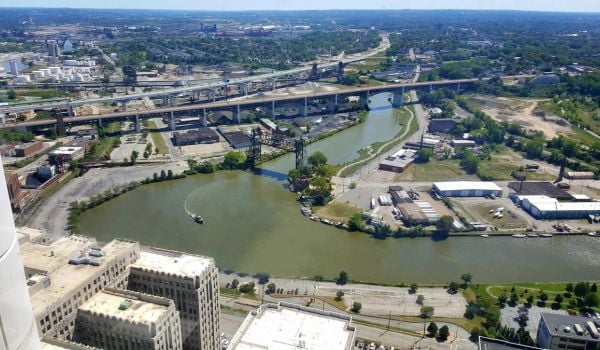Last night, PennPraxis presented A Civic Vision for the Waterfront, to a crowd at the Pennsylvania Convention Center so large it spilled out of the 900 seat chamber and into a simulcast room. The plan for Philadelphia’s waterfront along the Delaware river was clear, well presented, and intelligent. Or was it a vision? Perhaps a vision plan?
Whether to call it a plan or a vision may seem trivial, but understanding the nuance of terms could be the difference in whether someone left the presentation excited about the future of Philadelphia, or puzzled (even angry) by the many questions A Civic Vision for the Waterfront raises. Long term, it could mean the difference between success and failure.
Before I debate whether this was a presentation of a vision or a plan (and why that matters), a quick recap.
The night started with a few words by Harris Steinberg, head of PennPraxis, who then introduced a video which harkened back to Philadelphia’s industrial history and highlighted the civic visioning process. Kudos to PennPraxis for not shying away from, but showing, the challenges and struggles they faced during the year-long process. Councilman Frank DiCicco, who helped initiate the process, followed with some additional words about the planning process. Mayor John Street concluded opening comments by sharing his hopes for the legacy of the document, and it was time for the big show.
Steinberg presented the vision in three sections: Movement, Parks and Open Space, and Land Development. Movement was all about extending Philadelphia’s traditional street grid to the water, a proposal which the audience seemed to support. The Daily News was even outside in the atrium, selling “Grid is Good” t-shirts. Parks and Open Space weaved together an elegant green park system that crept back into the city and knit together neighborhoods along the waterfront. Steinberg hit the nail on the head when he commented, “green is the new infrastructure.”
Land Development is where things got a bit sticky. Tension was palpable at times, especially when audience members shouted that the development schemes were “for the rich,” and raised concerns about the public waterfront access given the proposed density of development. To the latter, Steinberg thoughtfully replied that “true public spaces such as the parks the plan proposes are the centerpoint of democracy.” (Check “Challenging the Commons” from TNAC issue 16 to read about access issues of privately-owned public spaces, which Steinberg stated there would be few – if any of.)
While most of the visual aspects were clear and easy to understand, I was sometimes disappointed by renderings of street corridors, which attempted to solve problems and provide a way for participants to envision the future development, but came off as generic and unlike the gritty and charming Philadelphia I know and love – to the point where some streets became unrecognizable.
The presentation ended with a computer-simulated flight through the newly envisioned waterfront, which evoked loud cheers and a standing ovation from the crowd. In that moment, I was proud to live in Philadelphia and, despite its current problems, was excited for its future.
As a vision, the presentation worked beautifully. If you allowed your imagination to run wild for a moment, you could almost see yourself celebrating the 4th of July or taking a jog along a new, green waterfront. However, if you were expecting a plan, for how we’d solve the Interstate 95 problem or – dare I say – what will become of the waterfront in the neighborhoods immediately around the proposed casinos, you may have left disappointed
These issues will have to be worked out in many plans, over many years. And while the presentation evoked such models as Chicago’s Millenium Park and New York’s Battery Park City, those cities operate in a much different political environment. As for Philadelphia, I think the time is right for us to believe in the vision. If we believe that we deserve an accessible, world-class, green waterfront (and we should) – we must hold our politicians accountable for implementing this vision in a fair, equitable, and environmentally sensitive way. Eventually, the individual parts will add up to a magnificent whole.
The plans may need a little work, but as for A Civic Vision for the Waterfront, the vision and framework is certainly there.
Hear what other Philadelphians thought of the presentation, courtesy of PlanPhilly.
Additional Coverage:
CBS3 News Coverage
Commentary from the Philadelphia Inquirer
Philadelphia Inquirer Coverage
– John C. Reinhardt is The Next American City’s interactive content coordinator and an MCP candidate at The University of Pennsylvania.











